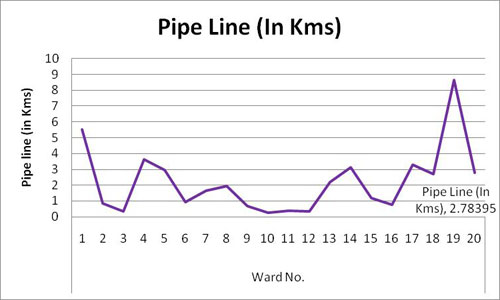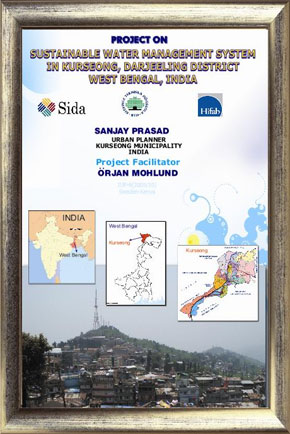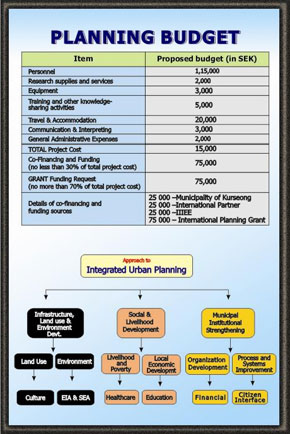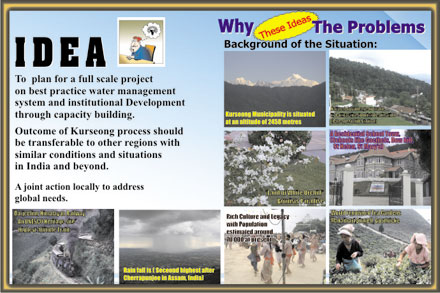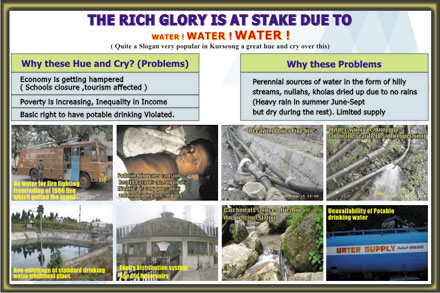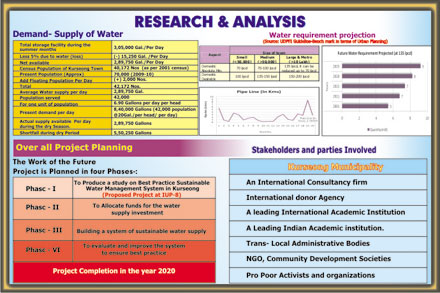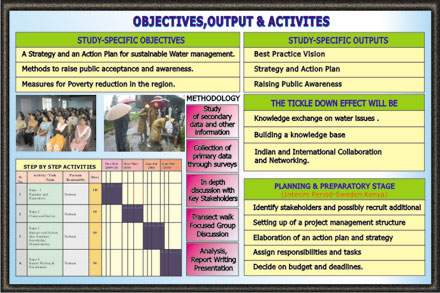| Indo-Swedish Project & Water Suply | |||||||||||||||||||||||||||||||||||||||||||||||||||||||||||||||
Background Mr. Lindblom met with the Kurseong Municipality for the first time in 2005 in a different matter. They kept in contact and in the fall of 2007 the Urban Planner in Kurseong Municipality, Sanjay Prasad, raised the issue of the failing water supply in the region. The discussions led to a proposal in the fall of 2008 by Mr. Lindbloms company Artamusto deal with the situation. The original proposal, however, never proceeded further due to local political indecision and lack of funds and it was concluded that new ideas were necessary to come to terms with the local and regional conditions. Hence the two parties Artamus (hereinafter referred to as the Consultant) and the Municipality of Kurseong (hereinafter referred to as the Municipality), have agreed to develop a project (hereinafter referred to as the Project) of sustainable water management. The parties have agreed to jointly apply for funds to support the development of environmental capacity building and continuous work towards infrastructural investments in the Municipality. The current proposal applies for a planning grant to carry out a study on sustainable water management and public awareness for the town of Kurseong in the Darjeeling District in West Bengal, India. The idea is to take the initial steps to plan for a full-scale project of a best practice water management system and institutional development through capacity building. The outcome from the Kurseong process should be transferable to other regions with similar conditions and situation in India and beyond. The objective of the collaboration is to in a joint effort act locally to address a global need: the need for capacity building at local and regional level on water management initiatives and innovations, through knowledge-sharing, to ultimately develop preparedness for sustainable (social, environmental and economic) infrastructural investments. Evolving transferable best practice solutions for reliable, clean and efficient water supply systems require extensive local and regional collaboration and a systematic as well as holistic approach. The preparatory and planning phases are important and even crucial in the development of a future full-scale project. The need to identify local and regional stakeholders and determine the preparedness of the municipality, establishing a clear picture of current public awareness and setting up a detailed timeline and budget are all fundamental steps towards infrastructural investments. The work of the future project is planned in four phases where the first phase will produce a thorough study of the current situation in Kurseong, the second will allocate funds for the jointly developed water supply investment, the third build the system of sustainable water supply and the fourth phase will evaluate and improve the system to ensure best practice. The aim is to complete these phases by 2020. The first phase, the study, will produce the following 4 deliverables: A) A vision for future sustainable water management The project will promote knowledge exchange on the issue of sustainable water management and will build a knowledge base by involving an Indian academic institution specialised in the field of water management. Such a partner will be sought during the planning phase and contact will be established between them and the IIIEE for future cooperation in the field.
The parties The lead partner of the project is ARTAMUS, an international consultancy network aimed at assisting organisations in the development of a sustainable society’, with which the first expert is Mr Mattias W. ALISCH, Partner and Senior Consultant whospecializes in programme and project development. The second Swedish partner is the International Institute of Industrial Environmental Economics at Lund University (IIIEE), with which the second expert Mr Andrius PLEPYS, MSc. in civil engineering; MSc environmental management & policy; technical PhD from IIIEE, senior consultant in the area of sustainable management is associated. IIIEE is an Institute that is engaged in multidisciplinary research activities with the overall ambition to develop strategies and policies that further systems of production and consumption, supporting sustainable development. IIIEE seek to facilitate the transformation of societies to sustainable development by utilising the synergies of cross-disciplinary education and research that is based upon direct engagement with private and public sectors and government. A leading university in India specialised in the field of water management will be sought during the planning phase to help build and maintain a knowledge base and exchange between Sweden and India on sustainable water management. Local administrative bodies on water distribution will be involved, as will local NGOs and other bodies working for the promotion of the situation of the poor. Their voices and concerns will constitute an essential part of the development of our study and future system, to ensure that the needs of the poor are met in every step of the process. The Indian partner to the project is the Hon. Chairman, Board of Administrator at Kurseong Municipality in West Bengal. Mr Sanjay Prasad, Urban Planner, Kurseong Municipality will be the Co-ordinator of the project and will be responsible for all communication and interaction. The Municipality is situated at an altitude of 2458 Mts.(4864 ft), 51 km from Siliguri and 30 km from Darjeeling, Kurseong's natural advantages make it a very attractive tourist destination. The rich flora of Kurseong town and surroundings is remarkable, and it has aptly been described as a 'Botanists' Paradise'. (http://en.wikipedia.org/wiki/Kurseong) The Municipality suffers, as numerous municipalities in the northern part of India, from torrential rains in the summer season, 2-4 months, and drought in the winter season, 4-6 months. It rains non-stop in the rainy season; in fact, Kurseong – “the land of the white orchid” receives the highest amount of rainfall after ‘Cherrapunjee’ in Meghalaya. Ironically, such heavy amount of rainfall is ideal for white orchids that adorn the hill-slopes of Kurseong in abundance. Despite the natural beauty of Kurseong, the poor infrastructure and lack of a commonly accepted and comprehensive water usage fee system leads to hampered economic growth resulting from the scarcity of water in the dry season. As a result the inhabitants suffer from a constant threat of dehydration, with the situation of the poor being the most precarious. Kurseong is one of four municipalities in the Darjeeling Region. The population is approximately 70,000, an increase from 15,000 in 1991 and 40,000 in 2001. Just like many of the Indian municipalities, Kurseong is currently going through a dramatic and rapidly evolving population increase.
Problem The characteristic of the water supply in the region of West Bengal, where Kurseong is situated, is heavy rains in the summer with excessive water supply and a dry period in the winter with water scarcity. The region seeks a sustainable solution to secure stabile and safe water supply year round. Presently the water supply in the town of Kurseong is a free of charge service for the community. The supply is poorly developed and suffers from leakage and similar maintenance related issues. The supply of potable water to the town is adversely affected as the catchment sources situated more than 12 km away from Kurseong are drying up due to deforestation. The local belief is that reforestation of the catchment sources could lead to the daily demand of the people being fulfilled. The old decaying & leaking pipes laid during the British Regime have to be replaced with new ones. The distributions system must be further modernised. The daily demand of the potable water is about 8,40,000 gallons (20 gallons per head per day) but in the lean driest period from March to June the people are getting only 2,89,700 gallons per day (a shortage of about 5,50,250 gallons) and the water is supplied in alternative days only. The entire distribution system is managed by the Municipality. Due to the age-old reservoirs and faulty distribution system the Municipality is facing acute problems in supply of water to the tax payers (property tax). During the dry seasons, at times distribution of water has to be made to the public through tankers and trucks. The existing water reservoirs and water distribution systems are in great need of modernisation in order to provide efficient service to the public. Kurseong town has quite a number of perennial and semi-perennial sources of water in the form of hilly streams and Nullahs (outfall). Such sources of water from the following streams, which are also known as Nullahs and Kholas, are impounded with small setting tanks and reservoirs for storage of water for supply to Kurseong town. As Kurseong has naturally sloped areas, the gravity flow system has been adopted for channeling and distribution of water to different places. Kurseong Municipality has no tube wells nor any pumping stations. All water is after preliminary sedimentation of filtration directed towards the primary reservoirs through different sizes of G.I. pipelines from their respective natural springs located in dense forest areas at distances from 2 to 20 km from Kurseong. The day to day requirement of potable water per day/per head is about 20 gallon. This can be made available to the public during the rainy, autumn and winter seasons. But the water scarcity is strongly felt during the three summer months as detailed below:-
Water requirement projection The water supply requirement for 2025 of Kurseong Municipality has also been estimated assuming the quantity of water required as 135 liters per capita per day, as per UDPFI Guideline and considering the increasing demand for water in the Municipal area.
(Source: UDPFI Guideline-Bench mark in terms of Urban Planning)
The existing capacities of all the above reservoirs inadequately cater to the present demand due to the expected increase in population in the command areas. The supply is done on alternative days in most of the areas, especially during the dry season. In view of this scarcity, water is brought from the jhoras (outfalls from hills) in trucks, jeeps, water tankers for supplies to house holds, hotels, restaurants, commercial establishments and other during water scarcity months. Some of the new commercial complexes & Dormitory and Housing complexes are under construction in the area of Kurseong Municipality, which will also require adequate supply of potable water. It is therefore imperative and necessary to realign the water supply pipe lines in the town area & also those pipe lines from catchment areas to central water reservoir which were constructed during pre-independence days and replace the old and ineffective ones with new ones to ensure adequate supply of water. Additionally, the Kurseong town has no provisions of specified water reservoirs for fire fighting or any fire fighting devices in order to remain prepared against situations similar to the fire, which devastated Kurseong Town during the fire havoc in the year 1986.
Objectives The objectives of the planning and preparatory phase are to identify and evaluate the partnership, to recruit additional partners if necessary and to jointly develop the Project. The outputs from the planning and preparatory phase will be:
The aim of the Project is to develop a system of feasible user charge for the water supply where the funding would be returned to further develop and maintain water supply investments in Kurseong. The age-old distribution system of water supply needs to be revamped. In addition, improvement of the catchments areas, existing water reservoirs and addition of water reservoirs in some places are urgently required in order to maintain water supply to Kurseong town. The P.H.E. Dept is maintaining the Supply of water from the sources situated within the forest areas up to the Central Reservoirs located within the Kurseong Town. From these central reservoirs the Municipality of Kurseong is distributing water to the public. The main feeder conduit pipes from the source to the Reservoir are in a dilapidated condition and were laid nearly 30 years ago, but due to a financial crunch the P.H.E. Dept. has not been able to maintain these main conduits. This is causing profuse leakage of water, resulting in inadequate supply of water to the reservoirs. Moreover the condition of the distribution system within the town area is not good and needs replacement and renovation.
Activities The planning visit is expected to produce the necessary project management, action plan and strategy to commence a full-scale project on developing sustainable water management in the Municipality. The planning and preparatory phase of the Project will involve five stages.
All parties have preparatory work to carry out in their respective countries, but the consultant will also visit the contractor on site for an initial workshop. The objective of the workshop is to settle the above-mentioned tasks and agree on the design of the first phase of the full-scale project work, the report. During the planning phase the consultant is responsible for preparing and designing the content of the workshop. The contractor is responsible for communicating the need for the project and disseminating the planned phases at local and regional level. The results of the planning phase and the objectives of the subsequent project will be thoroughly disseminated by the contractor at local, regional and national level. Once the five above-mentioned tasks of the planning and preparatory work have been settled, the full-scale project will have a strong basis for creating the agreed study, including;
The full-scale project will eventually produce the report “Best Practice Vision, Strategy and Action Plan for Sustainable Water Management and Raising Public Awareness”, thus developing a program of assistance to the client in their work towards building a sustainable water management system. The program is based upon the clients’ conditions and their work in capacity building, which is in line with the national and local context and needs. With the collaboration of experts on sustainable water management from the IIIEE in Lund, Sweden, and officials in the Municipality, the report will develop best practice according to principles of sustainability and will be transferable to regions with similar conditions within India and beyond.
Budget Preliminary budget (max. 75.000 SEK from the Facility and 75 000 SEK from partners)
|
|||||||||||||||||||||||||||||||||||||||||||||||||||||||||||||||
PROJECT PICTURES
|
|||||||||||||||||||||||||||||||||||||||||||||||||||||||||||||||

